Indications—Overview
The points suggested here should be checked with the point finder for electrical activity. Only active points will be needled. All descriptions refer to right-handed persons.
As the more experienced reader will already know, there are no treatment plans or recipes in ear acupuncture (except for the auxiliary lines and the addiction programs). The only points to be needled are those actually found to be active on the ear. The various combinations of points are only listed to give the practitioner an idea of how to develop his/her own concepts of acupuncture treatment in relation to clinical considerations.
Pain points are usually treated with gold needles on the ear of the affected body side (of course, the final decision about the needle metal to be selected depends on the point finder). So-called Functional Points are described for the right-handed person. The needle metal to be used, or the ear to be treated, in the left-handed person can easily be deduced from this: the Functional Points lie on the other (contralateral) ear. After the treatment, it is of advantage to insert a permanent needle into the most important point(s).
 | An important note for therapists wishing to work exclusively with steel needles: always needle the point on the same ear for which the Gold Point is described, because this is the point that needs to be stimulated. |
In all stubborn cases that do not respond to therapy–and particularly when a good ear acupuncture treatment did not lead to early and significant alleviation of symptoms–one should consider the presence of a focal disturbance (see B. Strittmatter, Overcoming Blockages to Healing—A Manual for Health Care Professionals, Thieme Publishers, Stuttgart–New York, 2004).
The following foci are common and should be taken into account:
• Scars, especially those that healed secondarily (the size of the scar is not important), also drainage scars and internal scars resulting from surgery (including the scar from perineotomy).
• Chronic inflammation (tonsils, paranasal sinuses, hemorrhoids, pelvic inflammatory disease).
• Devitalized teeth or inflammation in the dental—maxillary region.
Disorders of the Locomotor System
Auriculotherapy of symptoms of the locomotor system (joints, vertebral column) always proceeds according to the same principle:
1 Local pain point (e.g., reflex point of a particular joint or vertebra)
2 The corresponding motor point on the back of the ear (forceps method according to Bahr), using a silver needle
3 Points in the corresponding sympathetic trunk segment, usually with silver needles
4 Anti-inflammatory, analgesic, and/or anti-rheumatic points
5 Points of focal disturbances, if present
This treatment plan is valid for both acute and chronic symptoms. Local pain points may also be pierced with two or three needles if the ear point occupies a wider area. Points for joints or vertebrae are needled, like all organ points, on the ear of the affected body side. So-called Functional Points are needled as described in detail (always use the other ear for left-handed persons).
Upper Cervical Syndrome (Craniocervical Syndrome)
Chief complaints: Occipital headache, migraine. In most cases, the syndrome is caused by myogelosis of the upper neck muscles and blockage of the upper cervical spine. As a rule, myogelosis will at some time cause blockages of facet joints. A properly placed needle in the corresponding ear point will prompt the body to release these blockages on its own within a short period of time.
Note: For each blockage there are usually counter blockages of facet joints at other sites. These must be included in the therapy; their points should be located on the ear and then needled.
• Local pain points of the upper cervical spine: for example, Point C0 as Gold Point on the ear of the affected body side.
• The corresponding motor points as Silver Points on the back of the ear (forceps method); in this case also Point C0/C1.
• Points of the counter blockage: for example, Point C7 as Gold Point.
• Points with spasmolytic and analgesic effects:
Point SI-3 as Gold Point on the right ear;
Point LR-3 as Silver Point on the right ear (synonym: Anger Point);
Point LI-4 as Gold Point on the right ear (synonym: Thalamus Point).
• Psychotropic points, if indicated:
Valium Analogue Point as Gold Point on the left ear;
Depression Point as Gold Point on the right ear;
Master Omega Point as Gold Point on the right ear.
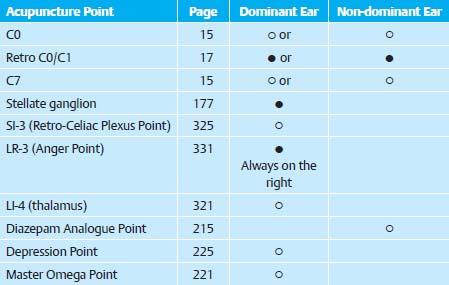
Chief complaint: Frequent pain in the shoulder, or in shoulder and neck, without any findings at the joints themselves.
Therapy:
• Local points of the cervical spine: usually Points C3–C5 as Gold Points on the ear of the affected side.
• The corresponding motor points as Silver Points on the back of the ear (forceps method).
• Points of the counter blockage: for example, Point L4/L5 as Gold Point.
• Points with spasmolytic and analgesic effects:
Point SI-3 as Gold Point on the right ear;
Point LR-3 as Silver Point on the right ear (synonym: Anger Point).
Point LI-4 as Gold Point on the right ear (synonym: Thalamus Point).
• Points with antirheumatic effect: PGE1 Point as Gold Point on the right ear;
Thymus Gland Point as Gold Point on the left ear.
• Psychotropic points, if indicated:
Valium Analogue Point as Gold Point on the left ear;
Depression Point as Gold Point on the right ear;
Master Omega Point as Gold Point on the right ear.
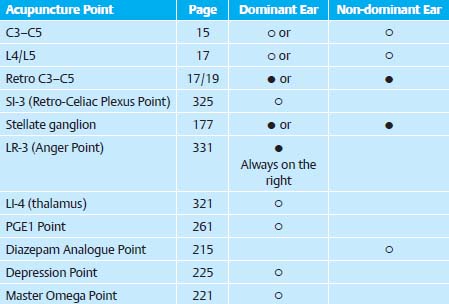
Lower Cervical Syndrome (Cervicobrachial Syndrome)
Chief complaints: Swollen hands, pain in the trapezius muscle.Therapy:
• Local points of the lower cervical spine (see Cervical Spine Zone), and points listed under middle cervical syndrome.
Note: The trapezius muscle is supplied by cranial nerve XI (accessory nerve), represented by the Accessory Nerve Point as Gold Point on the ear of the affected side.

Blockage of the First Rib
Chief complaint: Pain while lifting the arm, or even in resting position, caused by unilateral (rarely bilateral) blockage of the 1st rib. Treatment of the points along the auxiliary line of the First Rib Point releases the blockage.
Therapy:
First Rib Point, Stellate Ganglion Point, Point Zero (synonym: Celiac Plexus Point).
Note: Repeated blockage may indicate a focal disturbance.

It is self-evident that there should be a neurological examination of the lower limbs prior to every treatment of lumbago or sciatica (Lasègue’s sign, reflexes, weakness in the dorsiflexion of big toe and foot, epicritic and proprioceptive sensibilities of the dermatomes). A disk prolapse justifying surgical intervention is not a primary indication for acupuncture, although pain treatment may be performed prior to surgery.
Therapy:
• Symptom points:
Points for painful muscles in the Zone of Paravertebral Muscles and Ligaments;
point of the prolapsed disk in the Zone of Intervertebral Disks;
point for the irritated segment in the Spinal Cord Zone (sensory portion).
• All points are needled as Gold Points on the ear of the affected side.
• The corresponding motor points as Silver Points on the back of the ear (forceps method).
• Points for the respective segment in the Sympathetic Trunk Zone as Gold Points on the ear of the affected side (sedation of pain-producing sympathetic activity).
• Spasmolytic points:
Point SI-3 as Gold Point on the back of the right ear;
LR-3 as Silver Point on the right ear (synonym: Anger Point).
• Analgesic point: Point LI-4 as Gold Point on the right ear (synonym: Thalamus Point).
• Antirheumatic points:
• PGE1 Point as Gold Point on the right ear;
• Thymus Gland Point as Gold Point on the left side.
• Psychotropic points, if indicated:
Valium Analogue Point as Gold Point on the left ear;
Depression Point as Gold Point on the right ear;
Master Omega Point as Gold Point on the right ear;
Psychotherapy Point (synonym: Bourdiol Point) as Silver Point on the right ear;
Anxiety Point as Silver Point on the right ear.
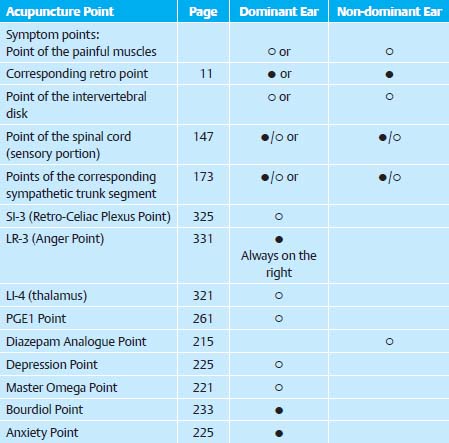
Also a small prolapse or a true irritation of the nerve root that should be treated conservatively can be treated as described above.
Note: All therapy of the spinal column should include physiotherapy, and weight loss if necessary, to stabilize the anterior and posterior trunk muscles.
Pain in the lower back, often caused by blockages of the small vertebral joints and/or concomitant myogelosis. It always makes sense to search for active points in the respective segment of the Sympathetic Trunk Zone (sedation of the pain-producing sympathetic activity).
 | Caution: If resistant to therapy, check the Depression Point for activity and needle if indicated. Symptoms of pain are often caused by a masked depression. |
Therapy:
• Symptom point: Point L5/S1 (affected in most cases) and the corresponding motor point on the back of the ear (forceps method).
• Points in the respective segment in the Sympathetic Trunk Zone as Gold Points on the ear of the affected side.
• Spasmolytic points:
Point SI-3 as Gold Point on the right ear;
LR-3 as Silver Point on the right ear (synonym: Anger Point).
• Analgesic point: Point LI-4 as Gold Point on the right ear (synonym: Thalamus Point).
• Antirheumatic points:
PGE1 Point as Gold Point on the right ear;
Thymus Gland Point as Gold Point on the left ear.
• Point with a general effect on the entire zone of the locomotor system: Zone Dominating Point ZC 2 (for the lower limb).
• Psychotropic points, if indicated:
Valium Analogue Point as Gold Point on the left ear;
Depression Point as Gold Point on the right ear;
Master Omega Point as Gold Point on the right ear.
Note: Repeated lumbago or lumbago-sciatica may indicate a focal disturbance.
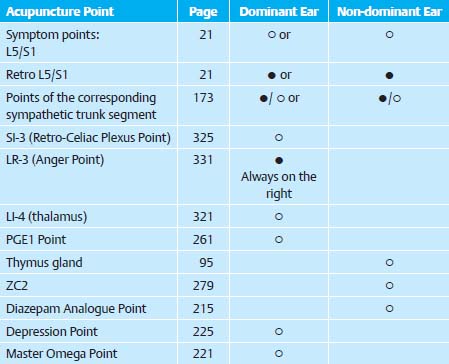
Blockage of the Sacroiliac Joint
Pain radiating into the leg (pseudoradicular irritation) caused by blockage of one or both sacroiliac joints. This certainly is the most misdiagnosed (unrecognized) cause of back pain. A crude test: direct pressure on the affected sacroiliac symphysis is painful; when bending forward the upper edge of the affected (blocked) ala of the ileum (posterior superior iliac spine) is asymmetrically drawn upward. Ear acupuncture may release the blockage.
Therapy:
• Sacroiliac Joint Point as Gold Point on the ear of the affected side, and the corresponding motor point on the back of the ear (forceps method).
• Points of the counter blockage: for example, Point C7 as Gold Point on the ear of the affected side.
• Cardinal Point SI-3 (spasmolytic effect; synonym: Retro-Celiac Plexus Point, Retro-Point Zero), as Gold Point on the right ear;
• Cardinal Point BL-62 as Gold Point on the left ear (synonym: Pineal Gland Point).
• Both Cardinal Points have a relaxing effect, especially on the sacroiliac joint, because they connect to two special meridians (Point SI-3 is the Opening Point of the Governor Vessel, and Point BL-62 is the Opening Point of the Yang Heel Vessel).
• Analgesic point: Point LI-4 as Gold Point on the right ear (synonym: Thalamus Point).
Note: Repeated blockage of the sacroiliac joint may indicate a focal disturbance.
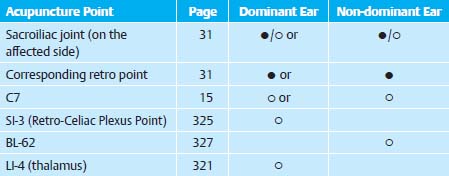
Bechterew’s Disease (Ankylosing Spondylitis)
In patients with this chronic disease, the two Cardinal Points SI-3 and BL-62 on the ear should be tried in any case, even if the loss of spinal motion is advanced. These two Cardinal Points have a relaxing effect especially on the sacroiliac joint because they connect to two special meridians (Point SI-3 is the Opening Point of the Governor Vessel, Point BL-62 is the Opening Point of the Yang Heel Vessel). This treatment results in pain reduction and, surprisingly, often in a wider range of spinal motion.
Therapy:
• Sacroiliac Joint Point as Gold Point on each ear.
• The respective motor point (for muscle relaxation) on the back of each ear.
• Point SI-3 as Gold Point on the right ear, and Point BL-62 as Gold Point on the left ear.

Unexplained pain in the coccyx; more common in females.
Therapy:
• Coccyx Point. A permanent needle in the painful ear point is often sufficient; the ear may be pre-pierced with a gold needle, if necessary.
Note: Resistance to therapy may indicate a focal disturbance.

Shoulder Problems
It should first be clarified whether the symptoms are only due to pain radiating into the shoulder from the cervical spine region (see under Cervicobrachial Syndrome). Frequently, it is not the joint itself that causes pain in the shoulder but insertion tendinopathies (supraspinatus and infraspinatus muscles, subscapular muscle); they are associated with a characteristic pain spot at the greater tubercle of humerus and pain radiating into the arm.
Therapy:
• Symptom point: Shoulder Joint Point as Gold Point on the ear of the affected side, and the corresponding motor point as Silver Point on the back of the ear (forceps method). It is essential to consider also the root of the problem (motor nerve supply of the shoulder): Point C3 in the Cervical Spine Zone.
• Analgesic point: Point LI-4 as Gold Point on the right ear (synonym: Thalamus Point).
• Antirheumatic and anti-inflammatory points:
Interferon Point as Gold Point on the left ear;
PGE1 Point as Gold Point on the right ear;
Thymus Gland Point as Gold Point on the left ear.
 | The same therapy is also used for periarthritis of the shoulder. Ear acupunctureleads to better mobilization during physiotherapy. |
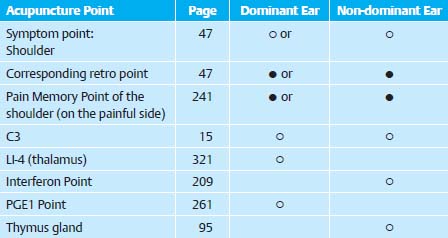
Tennis Elbow (Lateral Epicondylitis)
Pain at the lateral epicondyle caused by myogelosis in the extensor muscles of the forearm. Apart from mechanical strain of the elbow, symptoms are often caused by disturbed laterality (resulting from working with both hands, such as typing or piano playing).
Therapy:
• Symptom points: Elbow Joint Point as Gold Point on the ear of the affected side, and the corresponding motor point on the back of the ear (forceps method).
• Points in the Cervical Spine Zone (usually Points C7 and T1) as Gold Points on the ear of the affected side.
• Analgesic points: Point LI-4 as Gold Point on the right ear (synonym: Thalamus Point).
• Antirheumatic and anti-inflammatory points:
Interferon Point as Gold Point on the left ear;
PGE1 Point as Gold Point on the right ear;
Thymus Gland Point as Gold Point on the left ear.
• Laterality Point as Gold Point on the right side. (Attention: in left-handed persons as Gold Point on the left ear.)

To avoid surgery it is always worthwhile to try conservative therapy by ear acupuncture.
Therapy:
• Symptom points: local pain points or points of the inflamed tendons in the Wrist Zone as Gold Points on the ear of the affected side, and the corresponding motor points as Silver Points on the back of the ear (forceps method; for relaxation of the muscles).
• Points in the Cervical Spine Zone (with special attention to Points C4–C6) as Gold Points on the ear of the affected side.
• Anti-inflammatory point: Interferon Point as Gold Point on the left ear.
• Analgesic point: Point LI-4 as Gold Point on the right ear (synonym: Thalamus Point).
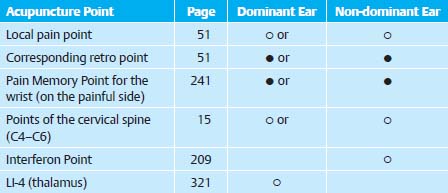
Dystrophy of the hand and forearm as a sympathetic reflex response resulting in disturbed circulation and metabolism of soft tissues and bones, usually after surgery (post-traumatic osteoporosis). The clinical symptoms tend to become chronic. Because this is dangerous for the patient, all possible therapies (including focal diagnosis and therapy) should be exhausted. It is always worthwhile to try local symptom points and also points that stabilize the autonomic nervous system and sedate sympathetic overactivity. Apart from the usual physical measures and medication, treatment with auriculotherapy is possible at any stage.
Therapy:
• Symptom points: points in the Wrist Zone as Gold Points on the ear of the affected side. Use permanent needles; the ear may be pre-pierced with a gold needle.
• Points of the respective segment in the Sympathetic Trunk Zone as Gold Points (or Silver Points) on the ear of the affected side (important to sedate sympathetic overactivity). (The needle metal, or the ear to be needled, must be determined with the point finder).
• Points that stabilize the autonomic nervous system:
Valium Analogue Point as Gold Point on the left ear;
Spleen Point as Gold Point on the left ear.
• Analgesic point: Point LI-4 as Gold Point on the right ear (synonym: Thalamus Point).
• Antirheumatic and anti-inflammatory points:
Interferon Point as Gold Point on the left ear;
PGE1 Point as Gold Point on the right ear;
Thymus Gland Point as Gold Point on the left ear.
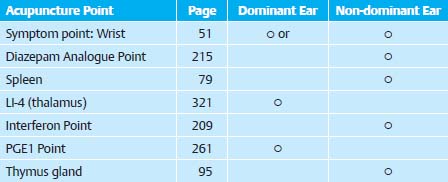
Therapy:
• Symptom point: Metacarpophalangeal Joint Point as Gold point on the ear of the affected side.
• Analgesic point: Point LI-4 as Gold Point on the right ear (synonym: Thalamus Point).
• Antirheumatic and anti-inflammatory points:
Interferon Point as Gold Point on the left ear;
PGE1 Point as Gold Point on the right ear;
Thymus Gland Point as Gold Point on the left ear.

Coxarthrosis (Osteoarthritis of the Hip Joint)
Even in cases of advanced coxarthrosis, soothing of the symptoms can be achieved with auriculotherapy, and the ability to walk can be maintained for a long time in older persons (especially when surgery is no longer possible).
Differential diagnosis: pain on palpation in the inguinal region. Athletes (especially soccer players) frequently suffer from a sudden onset of insertion tendinopathy of the adductor muscle at the inferior ramus of pubis. Here, a permanent needle in the corresponding ear zone (close to the Hip Joint Point) is often sufficient.
Therapy:
• Symptom points: Hip Joint Point as Gold Point on the ear of the affected side, and the corresponding motor point as Silver Point on the back of the ear (forceps method, because of myogelosis of the adductor muscles).
• Analgesic point: Point LI-4 as Gold Point on the right ear (synonym: Thalamus Point).
• Antirheumatic and anti-inflammatory points:
Interferon Point as Gold Point on the left ear;
PGE1 Point as Gold Point on the right ear;
Thymus Gland Point as Gold Point on the left ear.
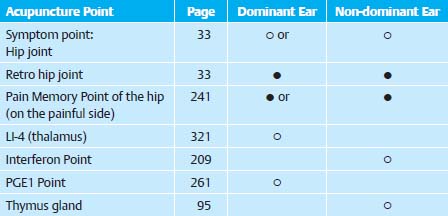
All diseases of the knee joint (gonarthrosis, meniscopathy, chondropathy of the patella) require the same therapy: symptom points as well as anti-inflammatory, antirheumatic, and analgesic points.
Therapy:
• Symptom point: Knee Joint Point as Gold Point on the ear of the affected side (may require several needles next to each other).
• Anti-inflammatory point: Interferon Point as Gold Point on the left ear.
• Antirheumatic points:
PGE1 Point as Gold Point on the right ear;
Thymus Gland Point as Gold Point on the left ear.
• Analgesic point: Point LI-4 as Gold Point on the right ear (synonym: Thalamus Point).
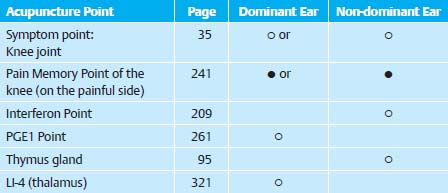
Pain underneath the patella (chondropathy of patella) is especially difficult to treat with conventional methods. Auriculotherapy is usually successful within a few sessions and may bring about complete freedom from symptoms (same therapy as for gonarthrosis, see above).
Concomitant exercise of the quadriceps muscle is essential because instability in the knee joint may produce pain.
It is essential to clarify whether “pain in the knee” is not just a simple irritation of the pes anserinus. (Irritation of the muscle insertion of the adductor muscle of the thigh at the medial superior tibial ridge is interpreted by the patient as pain in the knee.) A thin steel needle placed directly in the muscle insertion (primary pressure spot) so that it has contact with the bone often results in immediate freedom from pain (and thus excludes the knee joint itself as the cause of pain). Another needle in the reflex point on the ear is often no longer necessary.
Ankle Joint Problems
Pain in the ankle joint caused by arthropathy, ligament lesions, or distortions. Fresh distortions are especially responsive to emergency needling; a permanent needle placed exactly in the reflex point on the ear is often sufficient. But also pain caused by chronic osteoarthritis of the ankle joint can be treated, and nutrition in this region improved, by needles in the ear.
Therapy:
• Symptom point: Ankle Joint Point as Gold Point on the ear of the affected side (this may require a few needles next to each other).
• Anti-inflammatory point: Interferon Point as Gold Point on the left ear.
• Antirheumatic points:
PGE1 Point as Gold Point on the right ear;
Thymus Gland Point as Gold Point on the left ear.
• Analgesic point: Point LI-4 as Gold Point on the right ear (synonym: Thalamus Point).
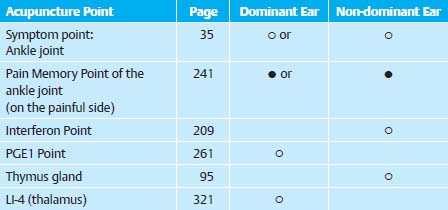
Pain in the Achilles tendon. Auriculotherapy yields excellent results, with immediate freedom from pain in most cases.
Therapy:
• Local point: Achilles Tendon Point as Gold Point on the ear of the affected side. (A permanent needle is inserted exactly into the active point; this often requires two gold needles for pre-piercing.)
• Anti-inflammatory point: Interferon Point as Gold Point on the left ear.
• Antirheumatic points:
PGE1 Point as Gold Point on the right ear;
Thymus Gland Point as Gold Point on the left ear.
• Analgesic point: Point LI-4 as Gold Point on the right ear (synonym: Thalamus Point).
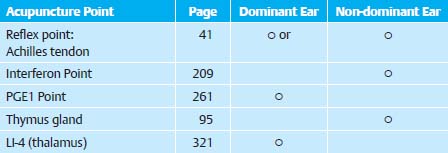
Pain in the heel bone. It can be successfully treated with auriculotherapy, even if the radiographs show a calcaneal spur. (Many calcaneal spurs accidentally discovered on radiographs have been free from symptoms for years.)
Therapy:
• Local point: Heel Point as Gold Point on the ear of the affected side. (A permanent needle is inserted exactly at the active point. Due to the point’s hidden location, the permanent needle is difficult to apply; it is therefore inserted into the hole left behind by the gold needle treatment.)
• Anti-inflammatory point: Interferon Point as Gold Point on the left ear.
• Antirheumatic points:
PGE1 Point as Gold Point on the right ear;
Thymus Gland Point as Gold Point on the left ear.
• Analgesic point: Point LI-4 as Gold Point on the right ear (synonym: Thalamus Point).

Burning sensation in the soles of the feet, usually on the lateral side. This is mostly a female complaint. It is difficult to treat by conventional medicine.
Therapy:
• Local points in the Foot Zone as Gold Points on the ear of the affected side.
• Analgesic point: Point LI-4 as Gold Point on the right ear (synonym: Thalamus Point).

Gouty Toe
Auriculotherapy in addition to the usual medical approach regarding the underlying disease.
Therapy:
• Symptom point: point of the big toe’s metatarsophalangeal joint in the Foot Zone as Gold Point on the ear of the affected side.
• Anti-inflammatory points: Interferon Point as Gold Point on the left ear; Thymus Gland Point as Gold Point on the left ear.
• Analgesic point: Point LI-4 as Gold Point on the right ear (synonym: Thalamus Point).
• A point that is energetically stabilizing: Kidney Point as Gold Point on the right ear.

Rheumatoid Arthritis (Chronic Polyarthritis)
It is not recommend that the beginner treats patients with true rheumatoid arthritis. There are usually multiple focal activities that support the inflammatory activity of the disease. In addition, once the disease has been going on for a long time, there is a tendency for concomitant emotional reactions that can enhance the sensitivity to pain via changes in the neurotransmitters.
Therapy:
• Symptom points: Points of the affected joints as Gold Points on the ear of the affected side.
• Anti-inflammatory point: Interferon Point as Gold Point on the left ear.
Stay updated, free articles. Join our Telegram channel

Full access? Get Clinical Tree


